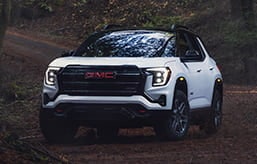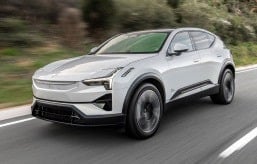- The Chevy Colorado is one of our top-ranked midsize trucks.
- For camping, the Colorado's standard bed lighting is inadequate — among other problems.
- Thankfully, there are factory options to rectify some of our complaints.
Our Long-Term Chevy Colorado Is Not a Great Camping Companion
Yes, we could have optioned it better, but Chevy could also stand to make some changes
With camping in my plans, the idea of taking one of our long-term midsize trucks along for the experience was appealing. For this trip, I'd be going to WeatherTech Raceway Laguna Seca, so a pickup wasn't explicitly necessary but, hey, trucks are fun on a road trip. Of our three long-term midsize trucks, the Chevy Colorado, Ford Ranger and the Toyota Tacoma, I settled on the Colorado. It's my personal favorite of the bunch, but after a few days at the campsite, I had some … observations.
Why the Colorado?
Around our office, opinions really are divided evenly over which truck is the best. A quick check of our midsize truck rankings page shows a statistical tie between the Ranger and the Colorado, with the Tacoma a not too distant, and still recommendable, fourth. (Shoutout to the Honda Ridgeline in third.) Everyone has valid reasons why they prefer one truck over the others and I've certainly got mine for the Colorado. For starters, I strongly prefer the styling of the Chevy over the other two. I think it looks strong without being cartoonish and it cuts a nice profile. The Ranger looks good to me, too, but in our truck's Lariat FX4 trim, it lacks a bit of toughness you get with the Chevy. As for the Tacoma, well, I think it looks like a Transformer's junk. And I'm not driving an orange truck. It's obnoxious.
I also like the Colorado's powertrain. Our truck has the high-output motor, which makes a robust 310 horsepower and 430 lb-ft of torque. None of our trucks are equipped with a V6 engine anymore (only the Ford offers one nowadays), but the Colorado gives you the engine with the most similar power curve to one of those bygone engines. If you're wondering about the Colorado's fuel economy, I got 19.8 mpg using 91 octane over 700.5 (mostly) highway miles.
I'm also a fan of the Colorado's Google-based infotainment system. As an Android user, it's familiar and straightforward, and I prefer the way the screen is integrated into the dash far more than the Ranger's vertical format or the Tacoma's "where-do-we-stick-this-big-screen" placement.
As much as I'd prefer a shorter cab and a longer bed — you know, like trucks use to have — none of our long-term pickups are in this configuration. As a matter of fact, only the Tacoma and the Nissan Frontier still offer this far more practical and appealing body style (the profile of a four-door, short-bed pickup is ridiculous), so I was stuck with the clumsy "family-friendly" setup.
Now for the observations, or to be more specific, the gripes.
Gripe 1: Lighting
The casual six-hour drive up to Laguna Seca was a piece of cake in the Chevy. Even through hours-long stretches of 100-degree heat, the climate control never wavered and the ventilated seats were hugely appreciated. That's a big reason to take the Chevy over the Ford, right there.
A later departure meant I arrived at the campsite just after sunset and that's when things quickly started to go pear-shaped for the Colorado's camping prowess. I envisioned switching on the Colorado's bed lights to aid with the unpacking only to struggle with finding the switch to turn them on. After I dug out my own flashlights I realized that the cargo bed light "swtich" was virtual and buried in a touchscreen menu. That meant whenever I wanted to flick on the lights, I had to power up the infotainment screen and navigate menus. That's super dumb. A roof-mounted rocker switch, like the interior lights get, would be a total no-brainer. On top of that, the bulbs for the cargo lights are not LEDs. They're dim and not particularly directional enough to light up the bed — their meager spread wastes what little illumination they make.
Another gripe about the lighting, and part of this falls on me, is our Colorado's lack of underrail bed lighting. I assumed that our well-equipped $48,445 Colorado Z71 would include those helpful lights, but it doesn't. As a stand-alone option, they're $350. That seems silly for a high-trim level truck but I'm also genuinely surprised we didn't spec that when we bought our Colorado. In fact, the lights aren't standard on any trim of the Colorado. That seems a bit cheap on Chevy's part, but it's a must-order if you're going to go camping or overlanding in your Colorado. For comparison, LED bed lighting is standard on much of the Ranger and Tacoma lineup.
Gripe 2: Charging
I didn't think it was too much to ask to push a quick charge into my phone at the start of every day, but the Colorado made me wish I'd just brought a rechargeable battery pack instead. My phone wouldn't charge via cable (or the wireless pad) without the truck being powered up in its accessory mode. I closed the door because I didn't want to hear the door chime go off (and neither did anyone else), and the truck powered itself off after 10 minutes. Great. Going back and forth between the camp stove and the truck just to make sure my phone got some juice was annoying.
Compounding that was the low battery warning the Colorado gave me on the second morning. Really? Once set up, I had disabled the Colorado's interior lights (my flashlights are way better) so the only known draw on the battery was when I was charging my phone in the morning. The low battery warning insisted I start the Colorado and let it run to charge itself back up, but it was something I had to do every. Single. Morning. As I didn't want to walk around begging other campers for a jump, I obliged. Hey, who doesn't like hearing a truck engine idling for 15-20 minutes every morning while camping?
As with the bed lighting, it turns out there's a likely fix for this inconvenience in the options sheet. As part of the Advanced Trailering package, Chevy offers a 220-amp alternator. Standard on the Colorado is a 170-amp unit, and while it doesn't seem like much, that 50-amp bump could be enough to better charge the Colorado's battery when you're idling. A more powerful alternator also helps take the load off the battery when driving at speed as it can make more than enough power to run accessories, like air conditioning and the myriad of other electronic systems in the truck on its own — again, saving the charge in the battery.
Edmunds says
Camping should be all about relaxing, and not getting frustrated or having to worry about your rig, whatever you bring along, is paramount. As it stands, I'd be less inclined to make the same trip again with our Colorado because it lacks some common sense features (partially on our part and partially on Chevy's) that would make truck camping far easier. Trucks have the benefit of a huge aftermarket of options, but it pays to check some boxes on the order sheet before you start bolting stuff on. And don't even get me started on why we didn't option our truck with a spray-in bedliner.







 by
by  edited by
edited by